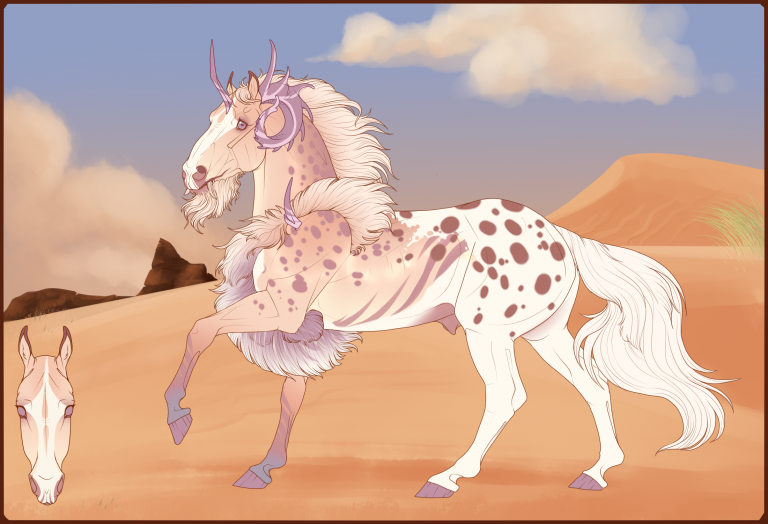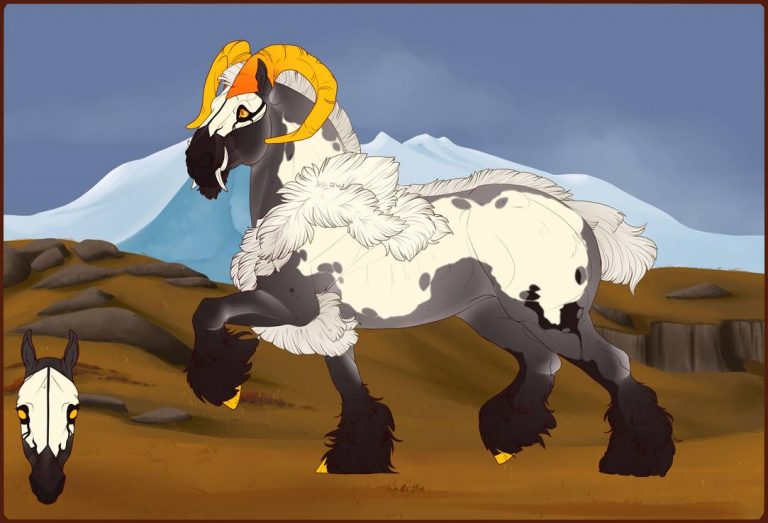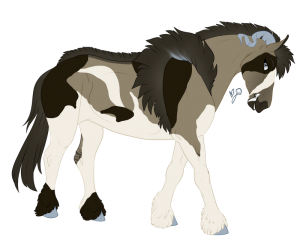Breeding
Introduction
Perhaps one of the most enjoyable aspects of Ballator ownership is bringing new Ballators into your stable! While at first glance the system looks long and complex, fear not! It’s simpler than it seems, and the admins are always around to help you if needed.
Members of Equus Ballator are allotted a maximum of three (3) breedings* per month. This means you may send up to three (3) separate notes or one note with three (3) breeding pairs! There are, however, some items or events that can grant you one or more extra breeding slots to be used at will.
*Breedings refers to one pair of horses being bred.
Additionally, each individual Equus Ballator is allotted 10 initial breeding slots. More can be gained through stats or other events.
Links for your Convenience
Submit a Breeding (DA)
Table of Contents
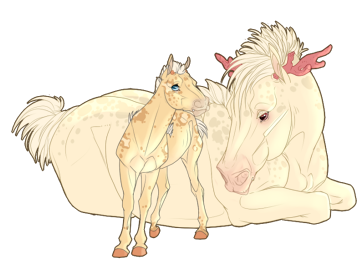
Breeding Basics
Breeding Slots and Owner Breeding Rules
The first and most vital step to breeding your EB’s is locating a well-matched stallion and mare. Whether you are breeding for color, stats, type, or another reason, there are a few things to keep in mind:
- Some EB Owners have breeding rules, which are a set of rules that must be agreed to before breeding to their horse.The Ballator owner’s breeding rules must be agreed to before breeding. Many members of the group hold breeding requirements. Be sure to read these thoroughly, as you are bound to them once you breed. The EB group does not oversee breeding rules, and will only intervene if there is theft or fraud involved.
- All breeding rules are private agreements between members. The group does not regulate breeding slot rules, with the exception of the following;
-The slot rules are completely restrictive.
– The slot rules scamming or fraudulent in nature.
– Someone changes their rules after you agreed to them.
– Trying to make a user agree to the new rules after a slot has been purchased.
– Any breeding slots which have been sold prior to the purchasing of a horse must remain under the buyer’s name, and no new conditions may be added to that slot. It must remain untouched by the horse’s new owner.
Selecting a Pair
Both the sire and dam must be registered in the group. This simply means that their references have been accepted into the group gallery and their ID and import image is found in the BallatorDesignAdmin account. If a horse has been deceased, each slot holder has two months from the date of deceasing to use the slot.
Breeding pairs can be one of the following options!
– Two of your own horses.
– One of your horses, and one of someone else’s horses.
– Two horses belonging to another user(s) (with the appropriate permission granted)The sire and dam must be listed on each other’s slot registry/counter. The slot owner (breeder) must be listed as well. Breedings will not be valid if this information is not present.
Horses should not be closely related. Closely related Ballators which are bred will result in an inbred foal, which will have the possibility of inheriting a deformity or ailment of some sort. More information on inbreeding and crossbreeding can be found in a later section.
Sending in a Note
To read how to send a note via DeviantART, which we no longer use for Breedings, and read the note you receive, (the group is keeping this guide in case we must fall back to DA) click the button below.
The next step in getting your brand new baby Ballator is sending a breeding note through our forums. Only you and the admin team can see your thread, so keep that in mind if you sell or buy a genotype.
Thing’s You’ll Need
Before you send in your note, make sure you have the following:
- To be marked on the Sire & Dam’s current references
- Your Sire and Dam’s BallatorDesignAdmin plaques
- Clickable Links
- Patience!
…To Remember the Following:
- If a Ballator does not have a current reference accepted into the group, the breeding cannot be rolled!
– This goes for horses that have been sold as well. Sold horses must have an accepted ref from the new owner before they can be bred. - Sometimes the links break.
– If this happens, we can’t see the plaques and we will be unable to roll the breeding. PLEASE make sure your links are clickable! It’s ok that a plaque is blank!
– The plaque will be filled out by your faithful admins before the breeding is rolled.Ballators Used in this Example:
— 8558 | Plutus (herrpoliti)
— 8756 | Krystal (MonsLeonis)
Breeder: Fade–Touched
Step One
- The first step is to be marked on BOTH the Stallion and the Mare’s references.
- They look different because Herrpoliti and MonsLeonis both mark them differently, but Fade’s user name is marked off on both plaques as “good to go.”
- The mare needs to be marked on the stallion’s reference and the stallion needs to be marked on the mare’s reference.
Step Two
Locate the BDA Plaques!
- Go to the BallatorDesignAdmin account.
- Click “Gallery” & then type the ID number of either the sire or dam into the search bar.

- Click “search gallery.”

- At the time, Jamie’s plaque was the only one that came up, but if the ballator has children and grandchildren already, all of those plaques will come up too.
- Search for the correct plaque. Click on it.
- Use the link from the navigation bar or use the fav.me link that DeviantART provides above the Thumb code.
- The fav.me link is less likely to break, and is shorter, so it may be preferable.
Step Three
Navigate to the EquusBallator Community Forums, which you can find at EquusBallator.com and on the dropdown menu here, highlighted in yellow:

Once on the Forums, scroll down to GROUP ACTIVITIES & RESOURCES and select ‘Breeding Notes’.
Note that you must have an account on the forums to be able to post there!
*Please note that the appearance of the site may change; we will do our best to update this guide as quickly as possible!
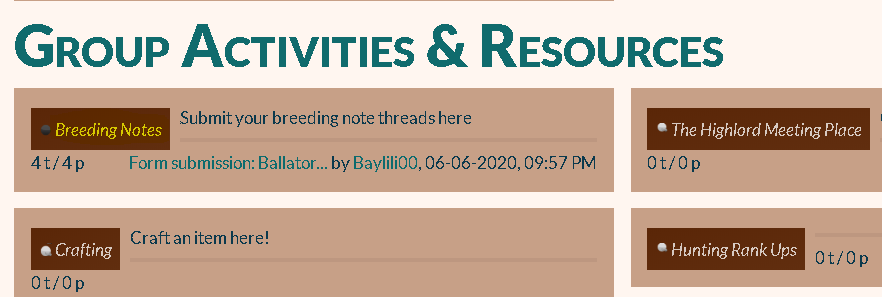
Once on the Breeding Notes page, on the right, click ‘Post Thread.’
You will be greeted with a BREEDING RULES banner; please read this before continuing!
Once you have finished reading the small rule paragraph, you will see that you are shown a form for entering all the info, which looks like this:
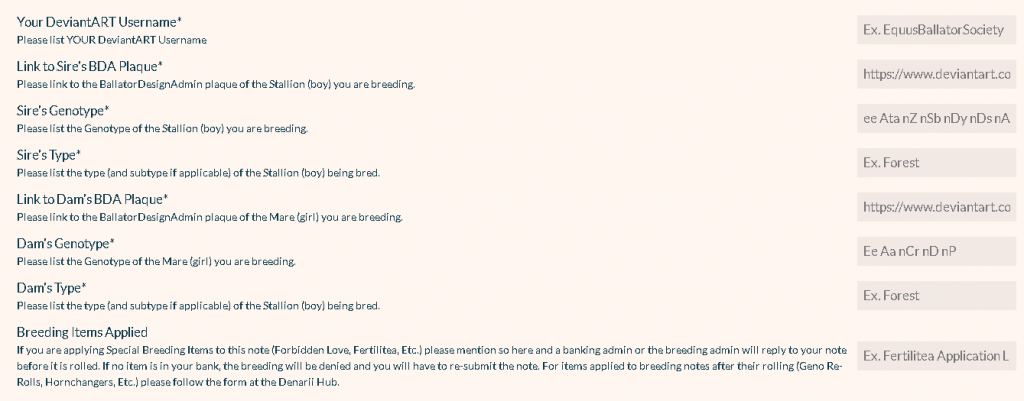
You will need to supply all the relevant information before you are able to submit the form; double-check to make sure that everything is filled out properly, like this example:
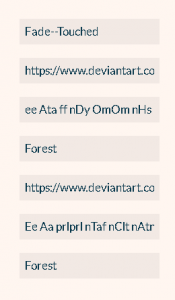
Once you have double-checked it, you can hit Submit Thread!
Now We Have a Little Wait!
The typical breeding turn-around time is always listed on the front page of the EquusBallator website.There may be changes to the turn around time depending on group activities and admin availability. DO NOT direct message an admin asking for after your breeding note. There will always be an announcement if things are longer than we estimate.
You’ve successfully sent in your first breeding note. Congratulations! Now, the hardest part is waiting for your note reply to arrive. When you receive your reply from the breeding Admin, you will get the following information:
- An ID number, unique for your horse
- Four genotypes to choose from
- The maximum amount of horns + possible extra horns for your horse
- Possible extra manes/mutations (if applicable)
- the inherited Stats, if any, your foal received at ‘birth’
- any other applicable information.
- One genotype (unless rare twins is rolled) is to be chosen and designed.
In the next section, we will cover Reading Your Breeding Note. Later on, we will go over Mutations, Inbreeding, Crossbreeding, and more!
Reading your Breeding Note
Provided you’ve sent in the breeding note in the correct format, our Breeding Admin will use our Breeding Roller to determine your foal possibilities. You will get back a note like this if your breeding has been successfully submitted:

ID, Details, and Type
- An ID number is assigned to every Ballator foal when their breeding note is rolled. It will be one of the first things listed on your breeding note with a link to it’s Plaque. The plaque will be blank until you design and submit your foal and it is accepted. Make note of the ID and Plaque, as it is very important for the design review and the registration process later on.
- The next section is what we will call the Details section. This section details your Ballator’s specific options and/or mandatory requirements. Since the note we are using has no details other than Health, only Health applies, but here are all possible detail elements that may appear in a note:
- This section shows your newly bred foal’s overall Health. Their health with never change over the course of their life, so whatever is posted in the breeding note is permanent. Of course, you can make a Healthy horse blind or deaf for story purposes, for example, but it is not ‘canon’ and if the horse is sold, the new owner can remove any non-required health issues as desired. If your foal rolls more than one ailment/deformity, it’s health will be determined by the least rolled health option; for example, if your horse rolls one Poor ailment (for example, blindness) and one Very Poor (for example, Short Spine), your foal’s health status will be Very Poor.
- If your horse is Cross or Inbred, the Health will appear under the Genotype. Health is rolled seperately for all four genotypes, so you may have different levels of health for all your Genos. Health cannot be swapped between genotypes.
- There are the following categories of health that are possible:
Healthy, Inbred, Crossbred, and Sickly, as well as sub-categories of moderate, poor, and very poor. If your horse is Healthy, it will not have a sub-category because it has perfect health. Sub-categories will apply to all the other Health options and will determine your horse’s ailments and/or deformities if applicable. Sickly Ballators are those who have issues related to their mutations, such as Stallions who carry the Carey gene or Double Merles. You can read more about diseases and crossbreeding/inbreeding affects HERE.
Moderate health Ballators are those with only slight ailments, such as floppy ears, deafness, or sterility.
Poor health Ballators have slightly more severe issues, such as blindness, crooked limbs, or neurological issues. Poor health Ballators cannot compete in the Tournament or in specific group shows.
Very Poor health Ballators have serious complications, such as Short Spine Syndrome, dwarfism, or bone issues. Very poor health Ballators cannot compete in the Tournament or in specific group shows, and when hunting, they have a lower chance at finding prey; foraging for plants or similar items is not affected.
Extra Manes are always optional unless it is stated that they are mandatory, for example, as with most Plains Ballators. You can pick and choose from any or all the extra manes shown in the Extra Mane category.
Some manes, such as Asiatic beards, can only be added to stallions, so be sure to follow the Extra Manes’ information carefully!
Your horse’s Calva is an inherited trait; for example, if your horse’s Dam has a lined shield, your foal will have a lined shield unless a Mutante Calvaria item is used. This section will tell you what your horse inherits from the parents and any possibilities therin.
If you have bred a Poecilia, you will see this detail in your breeding note.
Your options will be either Rump or Neck or possibly both, but you can only pick one.
Only Stallions can show the body mark, but mares will carry it, so make sure that when you upload your horse’s Design that you detail which body marking your horse has or is carrying.
If your horse’s parents have Capillae Striping or Hornfade, it will be noted in the details section that your foal may have these as well.
- The type of your Ballator is determined by their parents. It will be listed in your breeding note, as well, just under the Details section. The types are all very different, so make sure you pick the right set of type lines to design your Ballator on! Any crossbreeding will have the percentage of the cross listed; if your horse is a safe cross, even if it’s only, for example, 25/75 Mountain x Forest, you still need to design your foal on the Safe Cross lines.
- Subtypes are more specific ‘breeds’ within types of Ballators. The Asiatic, Lilliput and Mountain Ballators are currently the only ones who have subtypes. For the Asiatic and Lilliput types, the subtypes will be written in the breeding note, as well. For Mountain types, you are allowed to pick from ‘pony,’ ‘light’ and ‘draft’ subtypes no matter what the parents are.
Genotype and Phenotype
- To figure out the base coat (that is, the coat color all your mutations ‘sit’ on top of) of your Ballator, you need to look at their genotype and phenotype. Remember, you can only pick one of the four options in your breeding note (unless you rolled twins), so focus on one when doing this step.
- The first few letters of your breeding note will be some variation of “ee aa” which determines the true base coat of your Ballator. There are three true base coats in this group: bay, black, and chestnut. You can view examples of many base coats in our Visual Guides folder, as well as different mutations/modifiers in our Genetics journal.
- Your genotype and phenotype may also include a pattern, such as a white marking like Tobiano, Sabino, or an appaloosa pattern like Snowflake. White markings can be seen here: Genetics!
Mutations
‘Mutations’ in the EB group most often refers to ‘patterns’ such as Okapi Dun, Tuxedo, and Carey.
- The Equus Ballator group has a staggering amount of unique mutations. Browse the Mutations folder (link) to see guides to, and examples of, them! Mutations can affect the coats and the horns of your Ballator.
- The mutations have their own genes, which will be present in your genotype. They will also be written out in the phenotype.
- Many mutations have unique interactions with each-other, and differences based on if the gene is dominant, or not. Be sure to pay attention to the specifics in the guides!
(Ballator Mutations can be found under the “Mutations” subfolder in the “Resources” folder of the EquusBallator group.)
Horn Sets
- Your Ballator’s horns will be determined by their parents, as well! Your breeding note will helpfully tell you how many they can have, and where they can be located. Depending on the parents, some will be optional, and some will be required.
- Your Ballator’s horn color and shapes are determined by their parents, but are not given to you in the breeding note – you must mix the colors manually or use a HEX Code Generator to generate HEX codes and/or Palettes. Here is a Tutorial!
- For help picking a color, see How to get a Hex Code tutorial above, and for help combining the parents’ shapes, see EquusBallator: In-Depth Horn Genetics!
Randomly-Rolled Mutations
- If you’re lucky, you might get a randomly rolled mutation in your breeding note! There are seven coat mutations: Albino, Melanistic, Belton Spots, Bend-or Spots, Birdcatcher Spots, Somatic Mutation and Chimera. There are also two Physical mutations, Asinus and Saber. If randomly rolled, they’ll only apply to one geno in the note, not all four. See details on them here: Genetics.
- Mane mutations can also be randomly rolled in breeding notes. You can read about those in the Genetics page above as well!
- There are two types of breeding add-ons: inheritable ones, and optional ones. Inherited add-ons are things like capillae stripes and hornfade, which your Ballator may only have if their parents did, and if such is stated in the breeding note. The optional add ons are detailed in the Genetics page.
Inherited Stats
- If the parents of your Ballator have confirmed stats, then they can pass them onto their foals! Your breeding note will let you know if your Ballator can have inherited stats. Inherited stats are talked about in this journal: The Stat System.
- Your breeding note will either say that your horse doesn’t inherit any stats, or it will give you the exact number of stats it does inherit.
- Older breeding notes may just give you the parents’ confirmed stat rubric, in which case, you can use the Foal Stat Calculator to calculate your foal’s stats.
Inbreeding and Crossbreeding
Inbreeding and Crossbreeding can be dangerous to your foal or even your Dam. Knowing the complications associated with each can help you avoid them!
Inbreeding
What is Inbreeding?
Inbreeding occurs when one or more horses appear more than once in any given lineage. Inbreeding causes congenital defects and always will render a foal sterile. While inbreeding will not put your Dam at risk, the foal is at risk for ailments or deformities, which are explained a little bit later.
How can I avoid Inbreeding?
Before you choose two horses to breed together, make sure you study their lineages carefully. If you notice any identical ID numbers in the two lineages, do not breed these two horses unless you want to risk it!
What is the severity of Inbreeding Affects?
There are a many possibilities, and each one has a different chance of passing on to the foal. How closely related the parents are plays a factor in how many traits, and what traits, are passed on to the foal. Depending on the extremity of the inbreeding, foals will obtain sterility + 1 other trait (traits are listed below):
If the same horse is in one SSS slot and one DS slot for example (making the repeated horse only appear in the foal’s lineage once), the horse will be sterile with one possible ‘lesser’ affliction.
The two horses I plan on breeding have the same horse in their lineage, but only on the third column of their lineage. Will the foal still be inbred?
Yes. Even if the parents are only related by, say, a SSS, and the foal’s lineage will not show the duplicated ID, the foal will still have inbreeding affects. Any breeding pair that is found to have common relatives visible on their lineage charts will, with certainty, produce at least a sterile foal.
Starter Twins
In the Old EquusBallator group, new mutations were released via starters that were canonically twins, therefore they could not be bred. The following ID’s, although they will appear as starters in a lineage, are twins to another starter. These horses are always indicated in a Plaque Lineage to avoid anyone breeding them accidentally! Always check the plaque lineages in case the horse does not have Twins marked on it’s reference lineage.
Zebroid Twin Starters: ID 042 | ID 023


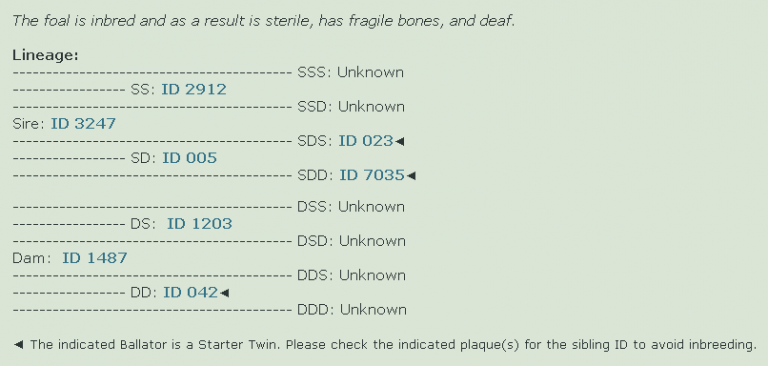
Crossbreeding
What is crossbreeding?
Crossbreeding occurs when two Ballators from different types are bred together. The more ‘Exotic’ the cross is, the more dangerous it is. For example, breeding a Desert Ballator to an Arctic Ballator is considered a very dangerous breeding as these two types are completely different in form, size, body type, and genetics.
There are, however, a collection of pairs that are safe to breed together and will not produce a critically ill foal. These are as follows:
-
- Mountain x Forest
- Desert x Steppe (produces Healthy but Sterile foals)
- Plains x Arctic
- Lilliput x African (produces Healthy but Sterile foals)
How can I avoid Crossbreeding?
Before you choose two horses to breed together, make sure you study their Information and ensure that they are compatible to breed together safely. You can, if you wish to crossbreed two different types who are unsafe to breed, use a Forbidden Love item to guarantee the foal is born alive, but it does not take away any possibility of defects.
Crossbreeding to generate an Unsafe Cross with any mare other than your own is prohibited unless Forbidden Love is used due to high death rate of the dam.
What is the severity of Crossbreeding Affects?
Any foal born with Poor or Very Poor health is not able to compete in the Tournament or specific group shows.
Exotic/High Death Rate crosses (anything with Deserts, Africans, Lilliputs, Steppes, or Asiatics. Even if your other parent is a non-exotic, the ‘exotic’s genetics take over) have the following statistics for rolling when using Forbidden Love. If not using Forbidden Love, a 30% chance of death is added, decreasing the percentages of the other possibilities:
-
-
- 10% chance of rolling Healthy
- 40% chance of 2 deformities and 1 ailment
- 30% chance of 2 ailments and 1 deformity
- 30% chance of 1 deformity and 1 ailment
-
Less Exotic crosses (not including compatible crosses such as Mountain x Forest, Plains x Arctic, Lilliput x African, and Steppe x Desert) that are between Mountain, Plains, Forest, or Arctic Ballators, have the following statistics for rolling when using Forbidden Love. If not using forbidden love, a 20% chance of death is added, decreasing the percentages of the other possibilities:
-
-
- 20% chance of rolling Healthy
- 35% chance of 2 ailments
- 20% chance of 2 ailments and 1 deformity
- 25% chance of 1 deformity and 1 ailment
-
Without use of Forbidden Love when crossbreeding, there is a chance for:
-
-
- Death of the Dam
- Death of the Foal
- Death of the Foal and Dam.
-
If these occur, both horses will be immediately be marked as ‘Deceased’ and will be unable to be used in the group. There is no way to revive a deceased horse.
Designing / Referencing Inbred or Crossbred Foals
When designing a foal who is inbred with ailments or deformities, these deformities/ailments may not be drawn on the Plaque Image. Plaque images will show the base design of the horse but will not accommodate deformities or ailments; these must be drawn on the reference only and must be accurate to what the deformity/ailment is. Ailments/deformities are always permanent.
When designing a foal who is crossbred, only safe crosses have their own lineart sets. You must use these line sets for safe crosses, no matter the percentage of the cross (for example, a 25/75 Mountain x Forest will need to be on the Mountain x Forest lines, NOT the Forest lines). For an unsafe cross, you must pick which type you’d like your foal to most represent, and then use the opposite type’s background as your foal’s background. For example, if a Mountain x Desert foal is to be designed, you can pick the Desert lines with the Mountain background, or visa-versa. When referencing a crossbred, for safe crosses, they must appear like their lineart counterparts. For other crosses, you can mix & match traits from both types.
For example, here are some references of crosses that all have varying elements of their Parent types:
Ailments and Deformities
Aliments are defined in the EB group as afflictions that do not drastically and detrimentally alter a horse’s physical appearance or life, but may cause some problems or issues, such as being blind.
Deformities are defined in the EB group as afflictions that drastically alter a horse’s life and cause extensive physical changes, such as missing limbs.
These ailments/deformities are permanent, even if they can be ‘corrected’ in real-life, in the EB group they cannot be removed, cured, or fixed. You are able to draw or create items for your horse to help it, such as artificial limbs for a limbless horse; this is noted in the next section.
Any foal born with deformities (other than hermaphroditism), fragile bones/horns, or one that is blind is not able to compete in the Tournament or specific group shows. These will be defined in the Tournament or Show in which they cannot enter.
To view a list of all deformities and ailments, along with photographs or illustrations of them, click on the blow button.
DISCLAIMER: some people may find some images disturbing; while in real-life these are very sad, our goal here is to educate on the severity of these illnesses or ailments and not to scare individuals. Illustrations/images have to be physically clicked on to view, so there are NO images on the following page, only information and links!
